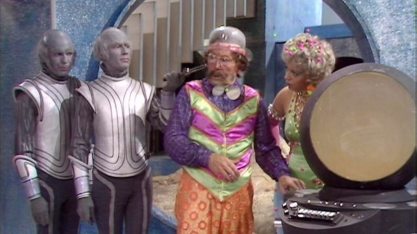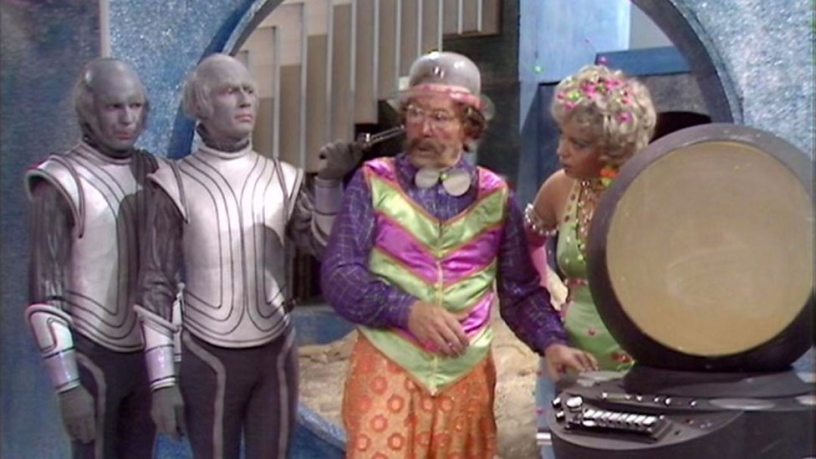
“You’ve discovered television, haven’t you?” asked the Doctor, back in 100,000BC. (Not “invented,” but “discovered”. Such an odd choice of verb. Like an exotic island he came across on a map.) He’s trying to explain to his new human companions why the TARDIS is bigger on the inside and he equates television with putting “an enormous building into one of your smaller sitting rooms”.
It’s a strange analogy. It seems to indicate that the writer doesn’t quite have a grasp on how television works – as if it still seems like magic to him. Like the TARDIS, a TV is a box in which impossibly large spaces – whole worlds, in fact – are contained. Walking into the TARDIS, the Doctor is saying, is a bit like if you could walk into your television set.
From the same magic box in the space year of 1973 comes Carnival of Monsters, a joyous, colourful splash of fun in the usually po-faced Pertwee era. It’s the story of when a planet “discovers” television and everything goes to hell in a dimensionally transcendental handbasket.
Television arrives on the dry and dusty planet of Inter Minor in the form of a “miniscope”. The miniscope is like TVs used to be – a bulky, awkward piece of furniture, which has to be manhandled into position (in this case by a group of rubber faced “functionaries”). The import of its heft may be lost on anyone who has grown up in the era of flat screen TVs, but in the olden days, TVs were big boxes which fuelled many a child’s belief that little people lived in the TV and performed all the programs live. Imagine if you could have put your hand inside and interacted with those miniature thespians within. Wouldn’t every young Doctor Who fan would have loved to reach into that box and pluck out the TARDIS, as happens at the end of Episode One?
When televisions first arrived in houses, they were disruptive elements. Evening schedules were rescheduled so families could huddle around them. Other recreational activities were dropped. Visitors without TVs popped in to see what all the fuss was about. Social rules got rewritten. Old habits were challenged. So it’s no surprise then that the miniscope causes a sensation on Inter Minor.
It’s a planet inhabited by grey-faced bureaucrats (literally). We meet a triumvirate of these pompous pen pushers: permanent flustered Pletrac (Peter Halliday), permanently bemused Orum (Terence Lodge) and slippery eel Kalik (Michael Wisher). This fussy trio bitch and whine and generally keep us amused with their stuffy language and their love of procedure. But still, they don’t hesitate to shoot down protesters in the street if they dare to dissent. Inter Minor’s still a police state, even if the representatives of that state are played for laughs.
The scope’s operators – Vorg (Leslie Dwyer) and Shirna (Cheryl Hall) – are the ones who bring the device to Inter Minor, tumbling with it out of the back of a cargo ship. Vorg and Shirna are wildly different to the Inter Minorans. He dresses in a Sixth Doctor-esque ensemble, except turned up to 11, and she dresses in Peri Brown lycra, only more of it and with more baubles. That they are different to the drab officials around them is obvious. But because of their stewardship of the miniscope, I think writer Robert Holmes is equating them with people who make TV programs. They are illusionists, storytellers and scammers. Viewed by those around them as glitzy showbiz types. Slightly untrustworthy. TV types as the new carnies.
The Inter Minorans are suspicious of Vorg and Shirna, but it’s more than just old fashioned xenophobia. They don’t understand the purpose of the miniscope. It arrives to disrupt their world, as surely as if it turned up in their living rooms, and they’re worried. What new, dangerous ideas might it introduce into their tightly wound-up society? Vorg has to reassure them: “Our purpose is to amuse, simply to amuse. Nothing serious, nothing political,” he has to say. That TV is viewed as a dangerous, potentially subversive element would not have been a concept unheard of in the age of Mary Whitehouse.
When Vorg starts to demonstrate the ‘scope, its similarity to television becomes clear. You can switch channels to watch programs about Ogrons, Drashigs or Cybermen. When the reception goes bad, it’s like “watching a blob in a snowstorm,” and Shirna wonders who’s going to pay good credit bars for that (a familiar complaint for UK viewers who pay a licence fee). Yes, the scope is clearly signalled as a sci-fi peepshow, but Holmes is pointing out that TV is the contemporary equivalent.
Holmes is also showing the authorial choices that TV makes employ to create that peepshow. He uses Vorg to do this. One of the shows you can watch on the scope is the mystery of the SS Bernice, a cargo steamer from the 1920s crossing the Indian ocean. Vorg demonstrates how if we wants to increase the tension in the scene, he need only turn up the “aggrometer” and the inhabitants – in this case the Doctor and young buck Andrews (Ian Marter) can be made to fight. Vorg is now Holmes, sitting in front of his typewriter and turning up of the aggrometer, is a writer amping up the tension in a scene. Or to choose a more modern example, it’s the producers of Big Brother or Love Island, deliberately stirring up their casts of fame seekers to manufacture some drama for their next episode. Poke ‘em with a stick and make ‘em jump, as the Doctor explains to Jo (Katy Manning).
Our heroes work out what’s going on by enduring multiple renditions of the same scene on board the SS Bernice, albeit with small variations each time (again, the drafting and re-drafting process of a script writer comes to life). They helpfully point out a few continuity errors like the calendar and the light outside being wrong. Then they clamber around its innards for a while, before the Doctor stumbles out of the box at the end of Episode Three. Another childhood fantasy enacted: that the people within the TV, might break out and escape.
That’s when it all turns back into a normal Doctor Who story. The Drashigs escape and run amok on Inter Minor, chewing up Kalik the would-be usurper in the process. The Doctor builds a gadget to fix everything. The scope blows a cathode ray tube or something and everyone goes home. All in all, a most diverting evening in around the box.
If we could chart classic Doctor Who’s representation of television, Carnival of Monsters is in the middle of a spectrum, which starts with Hartnell stories like 100,000 BC and The Chase which position it as a magical box of wonders, progresses through to Vengeance on Varos which shows it as a tool for suppressing the masses and ends with Remembrance of the Daleks, which revels in nostalgia for it. It’s a kind of emotional journey for the show, from reverence to suspicion and finally to affection. But of these, Carnival of Monsters is the wittiest, presenting TV as something which changes societies and commenting on how stories are constructed. Nothing serious, nothing political but definitely something fascinating.
LINK TO Twice Upon a Time: Both feature Cyber-cameos.
NEXT TIME… Monky business in The Lie of the Land.

Wow! Seriously, that was a very intelligent and insightful analysis. I don’t think I will ever be able to look at “Carnival of Monsters” the same again.
Truthfully, I have never been a huge fan of “Carnival.” The blame lays entirely on the novelization. I read it two or three years before I saw the actual serial. The book, playing out in my mind, had an unlimited budget and incredible special effects, and the story seemed amazing. Then when I finally watched the actual TV serial, it seemed cheap and gaudy and silly. Plus, y’know, there was that wacky Dudley Simpson music.
(This was definitely not the only time I would read a Target novelization before seeing a TV story, resulting in a certain disappointment.)
The only aspect of the televised version that was actually an improvement over what I imagined in my head was the Drashigs. I had imagined them as a cross between a brontosaurus and a tyrannosaurus. The giant worm / caterpillar creatures were incredibly imaginative & scary, especially with those shrieks of theirs. Difficult to believe they were only hand puppets. It’s one of those instances where Doctor Who did an amazing job creating something fantastic on a shoestring budget.
Anyway, having read your write-up, I now want to rewatch Carnival of Monsters. I’d probably enjoy it much more now.
Thanks Ben! I can recommend Katy Manning’s reading of that pesky novelisation. It’s a corker.